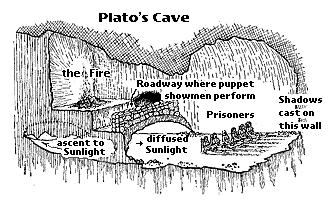The Allegory of the Cave
- Plato realizes that the general run of humankind can think, and speak,
etc., without (so far as they acknowledge) any awareness of his realm of Forms.
- The allegory of the cave is supposed to explain this.
- In the allegory, Plato likens people untutored in the Theory of Forms to
prisoners chained in a cave, unable to turn their heads. All they can see
is the wall of the cave. Behind them burns a fire. Between the
fire and the prisoners there is a parapet, along which puppeteers can walk.
The puppeteers, who are behind the prisoners, hold up puppets that cast shadows
on the wall of the cave. The prisoners are unable to see these puppets,
the real objects, that pass behind them. What the prisoners see and hear are
shadows and echoes cast by objects that they do not see. Here is an illustration
of Plato’s Cave:

From Great Dialogues of Plato (Warmington and
Rouse, eds.) New York, Signet Classics: 1999. p. 316.
- Such prisoners would mistake appearance for reality. They would think the
things they see on the wall (the shadows) were real; they would know nothing
of the real causes of the shadows.
- So when the prisoners talk, what are they talking about? If an object (a
book, let us say) is carried past behind them, and it casts a shadow on the
wall, and a prisoner says “I see a book,” what is he talking about?
He thinks he is talking about a book, but he is really talking about a
shadow. But he uses the word “book.” What does that refer to?
- Plato gives his answer at line (515b2). The text here has puzzled many
editors, and it has been frequently emended. The translation in Grube/Reeve
gets the point correctly:
“And if they could talk to one another, don’t you think
they’d suppose that the names they used applied to the things they
see passing before them?”
- Plato’s point is that the prisoners would be mistaken. For they would
be taking the terms in their language to refer to the shadows that
pass before their eyes, rather than (as is correct, in Plato’s view)
to the real things that cast the shadows.
If a prisoner says “That’s a book” he thinks that the word “book”
refers to the very thing he is looking at. But he would be wrong. He’s
only looking at a shadow. The real referent of the word “book” he cannot
see. To see it, he would have to turn his head around.
- Plato’s point: the general terms of our language are not “names” of
the physical objects that we can see. They are actually names of things that
we cannot see, things that we can only grasp with the mind.
- When the prisoners are released, they can turn their heads and see the
real objects. Then they realize their error. What can we do that is
analogous to turning our heads and seeing the causes of the shadows? We can
come to grasp the Forms with our minds.
- Plato’s aim in the Republic is to describe what is necessary
for us to achieve this reflective understanding. But even without it, it remains
true that our very ability to think and to speak depends on the Forms. For
the terms of the language we use get their meaning by “naming” the Forms that
the objects we perceive participate in.
- The prisoners may learn what a book is by their experience with shadows
of books. But they would be mistaken if they thought that the word “book”
refers to something that any of them has ever seen.
Likewise, we may acquire concepts by our perceptual experience of physical
objects. But we would be mistaken if we thought that the concepts that we
grasp were on the same level as the things we perceive.
 Here are some
students’ illustrations
of Plato’s Cave
Here are some
students’ illustrations
of Plato’s Cave
 Go back to lecture
on the Phaedo
Go back to lecture
on the Phaedo
 Go back to lecture
on the “One Over Many” Argument
Go back to lecture
on the “One Over Many” Argument
 Go to next
lecture on Criticism of Forms
Go to next
lecture on Criticism of Forms
 Need a quick
review of the Theory of Forms? Click here.
Need a quick
review of the Theory of Forms? Click here.
 Return to the PHIL 320 Home Page
Return to the PHIL 320 Home Page
Copyright © 2006, S. Marc Cohen
